The basic canvas wall tent, used by outdoor enthusiasts and the military for hundreds of years, can be turned into more than a tent with the simple addition of a wooden platform. My family has some property in a beautiful meadow with mountain views and we are looking to put up a canvas wall tent on a wooden floor to use for guest camping and enjoying the summer nights. Research for these tents has turned up some fantastic photos of what can be created with these portable but heavy duty structures.
Wall tents are different than tipis and in that they have four sides and a peaked roof, much like a tiny house. Canvas wall tents have been used by the military as early at 1740 and were used extensively in the American Civil War. Hunters and trappers in the 1800’s used wall tents while on the frontier and they are still used today as shelters in refugee camps and by soldiers in Iraq.
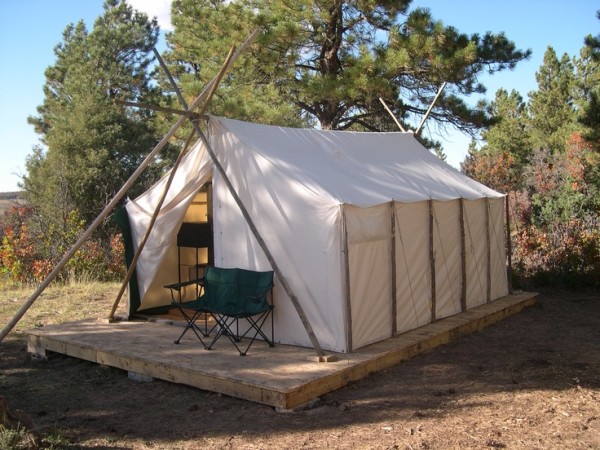
Canvas wall tents range in size from about 8-10 feet wide and 10-20 feet long. They can be supported with a simple wood frame, steel poles or traditional timber poles cut down on site. The walls are typically 5-6 feet high. Some canvas tents are large enough to contain a wood burning stove and the canvas roof can include a hole for a stove pipe. Furniture, carpets and even wall hangings can be used for interior decoration.
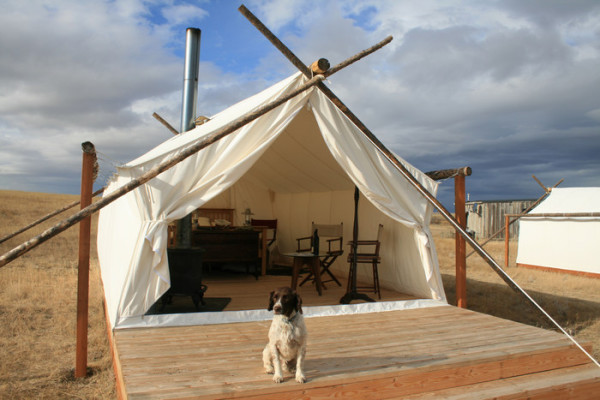
Canvas wall tents can actually be mounted to a hard surface deck. This keeps the tent from being blown away and damaged in the wind and also keeps out unwanted outdoor critters. These types of tents are called deck tents and can be secured even further with cable systems that tie the tent down to the deck.
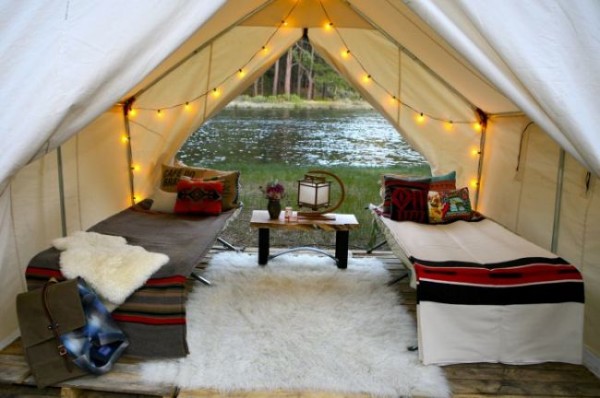
Because of their sturdy construction and ability to let in fresh air while protecting campers from the elements, many canvas wall tents have become popular for glamping enthusiasts. The tents can be enjoyed in the summer and fall and then packed up and put away when winter arrives.
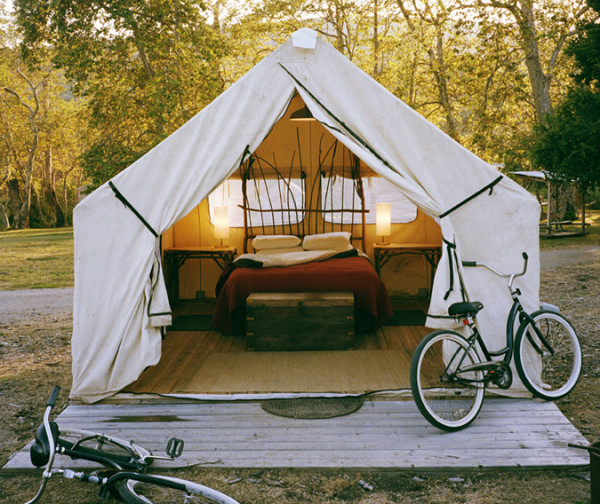
Photos by David Ellis Canvas Products, 1859 Oregon Magazine, Yellowtone Under Canvas and Rand McNally
By Christina Nellemann for the [Tiny House Blog]
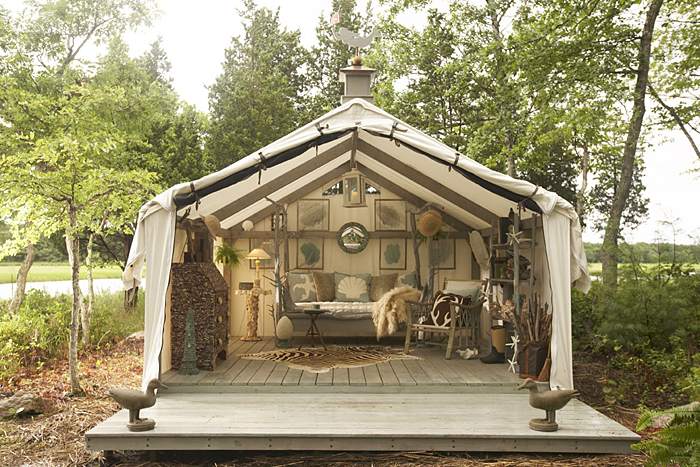
My aunt and uncle had to live in a tent like that whewn he came home from WW2. They saved up enought money to get their own house. The tent was a war surplus tent from WW2. The were very comfortable there.
I actually wanted to comment on the Grandma house a couple of posts back, but apparently I can’t.
I was interested because culturally in Switzerland, it was usual for a farmer to build a smaller house near the actual farmhouse. Often it was combined with some storage space, or in our case, with the laundry facilities. The intention was that when the young farmer took over the main house with his family, the parents could retire to their own space (usually 2-3 rooms) but remain active in the family farm community, working or helping with kids etc. and in return being cared for by the younger generations as they aged. The small houses are much sought-after and sometimes removed from the original property if no longer viable, an unusual undertaking in this country (usually stone/wood built). These days, a smaller “granny flat” is often built in the farmhouse itself; families are smaller so there is usually room for the older generation to enjoy some independence but remain active.
Our house was the laundry (built 1770) to the big old mill (built 1629) next door; now we are in the middle of a small town!
I love the tiny houses and was intrigued by the Grandma house, and would appreciate the siimple housecleaning, but where are her books?
LOL mine are in the hallway…!
Ah yes, tents! I love the idea, but living where winters get cold makes me desire something a bit more permanent!
While scouring the internet about tiny houses a long time ago, I wound up at this site:
http://www.alaskawintercabin.com/tent_in_tok.html
This is a most fascinating story of a family who endured living in a tent in Alaska while building their log home. It is well worth a read, and the site is so cool!!!
Thanks for the link Kae. Tough folks!
Having worked three seasons in the wilderness area south of Yellowstone Park, I have a great dislike for wall tents. Have to go out side to knock the snow off the roof constantly. Not the best in high winds. That being said, many people have been born and died in only a wall tent. A late friend of mine from Dillon, Montana told me living in a wall tent with her family in the 1930’s were the best years of her life.
While more common 120 years ago, getting ten plus feet of snow in one night is not a situation for anything other than a conical structure. From Lapland to Patagonia, having access to oxygen in the am is a good thing! 1888 is known to Crows as “the year we came out of our smoke flaps!”
I love the concept, but living in a cold and temperate northern area makes me think that for me these could only be a summer yard decoration and not much more. I know that some hunters in our area use these tents during the fall and early winter for hunting trips. They actually outfit them with wood stoves and everything on their short trips into the woods to make sure they’re nice and comfortable. I have to admit though, the decor in some of these is pretty gorgeous!
Take a look at the tent at http://www.vrbo.com/187089 or any of the Safari Tents T http://www.glamping hub.com.
This is a very old and Popularidea for extra space.
Hi there! Thank you very much for including a link to Glamping Hub. The URL is https://glampinghub.com
Please let me know if you need any assistance 🙂
I spent many a happy (?) summer in big canvas tents as a boy-scout on group camping trips.
The major issue is with canvas as a rain-proofing material – it relies on the surface tension of the water on the outside, and if you touch the inside wall with just a finger tip, that establishes a capillary and you set off an inside drip that won’t stop until the rain stops. Just be sure to have buckets on-hand in case someone tall bumps their head on the roof.
Notice how in most of the pictures (especially the one with the big puddle) there’s hardly anything near the walls. I imagine these tents would work great in the desert Southwest or even Appalachia in the summer, but for the Pacific Northwest forget it. As the Mongolians & Tibetans taught us after centuries of figuring this out, some kind of wall lining (as found in yurts) is essential to make a canvas tent usable in wet weather.
Not the case today, if you purchase the correct canvas. Todays diy wall tents have nothing on the old canvas tents of yesteryear.
I live in a variety of wall tent with my son, now on our second winter. We’re in Alaska. Ours is an all-season guide tent, with insulation up to about R7. We’re quite comfortable, though a bit cramped. this summer we’ll be building our own tiny house, which will not have a much larger footprint than the tent. Biggest problems: challenging to keep organized, a little gloomy in the winter when the window flaps have to stay closed, when the rain falls in the summer it is LOUD, like living inside a drum, and the floor is cold. If I were to do it again, I’d make sure the tent platform was insulated. bonus: it’s much easier to clear snow off the roof than in a hard shell home!
back when I was young I lived in a wall tent for a year outside of Whitehorse in the Yukon. It was an old white canvas one set on a house type frame with uninsulated wooden floor and walls and a loft, heated by an old tincan of an airtight. There was an old door built into the front wall which also provided the only window. Overheated in the loft, under heated below knee level. Nice and warm while the fire was going but if you went to town the stove would burn out fairly soon and you’d come back to frozen everything. Many old cabins had a wall tent as their starting point and were gradually built over, just left in place and roofed over and walled in.
They can be made very livable and comfortable and some are even insulated now. You can get windows, porches and various qualities of material. Not very critterproof though.
I’ve spent a lot of time in a Springbar 10 by 10 canvas tent. Canvas tents are hard to set up, and watch out when a big wind comes through, plus they’re cold/hot and offer very little in terms of safety issues. But I love the feel of being in one. I grew up camping in a big old army wall tent.
One of the best summers of my life was spent in a wall tent in North Central Washington. Even through furious thunderstorm – rain and wind – the tent was a great shelter. In the autumn we moved into a canvas tipi set up with a little stove. Though we had our rigid wall structure built for by full winter snow, I did have friends who lived in their tipi year round and for many years. When set up with flooring, liner and stove; it worked very well.
Tiny Tent Blog ….
When I was growing up, my dad always pitched a wall tent on a platform on Dabob Bay, and we kids all slept in it. When I bought my own property, my husband put up a canvas wall tent, complete with wood stove and furniture and rugs, and built a beautiful tent platform for his young daughter. He and I lived in a different camping tent on another platform as we built our “real” house, inspired by the tiny house movement. The problem with the canvas tent was mildew, which eventually destroyed the fabric. The mildew “bloomed” the very first winter, perhaps because of the wood heat inside?
Really Nice Tent.
I had picked up a few years back an ebook on making Tarp tents and I was really happy I did as I got to actually use the knowledge in constructing a simple but very cool tent when camping out for a few nights.
A sample of some other designs you can see here:
http://content.artofmanliness.com/uploads//2011/07/campfiretentsetups.jpg
There a many more based on your tarp/canvas size that can be constructed.
Having stayed in one very similar to the article I can give a tip that using the 1 inch foam constriction insulation used on the exterior of houses, on the inside of the roof between the rafters and canvas will cool it way down. Or you can simply use a second tarp to act as a double wall and shade the tent. They get extremely hot when in the sun. I mean brutally hot.
This advice is good for any tent really.
Thanks for the tips, chase. Since we are looking at just having the tent up in the summer and fall, the desert heat is a big worry for us so this helps.
Love the blog and the great pictures. One of the greatest benefits to wall tents is the ability to stay warm in the winter. Anyone that has camped in freezing temperatures can surely appreciate a tent that has a wood stove. However, now days they have become more popular for year around living, temporary and emergency shelters, and glamping. Wall tents offer the space and durability that most tents do not. For a lot of people they don’t want to mess with a camp trailer or have that expense but still want to enjoy the outdoors with a little more comfort. Wall tents fill that void well.
Justin
http://www.elkmountaintents.com
canvas tents are so easy to put up & have so much more room. Thanks for such a good link. thank you…
have a good day camping…
Grew up in Beckel Canvas tents from Portland Oregon, pretty sure they’re one of them pictured!! Great family business and great canvas tents!!! They keep ya warm in the winter with just a little stove in there!!
These canvas tents reminded me of my childhood…Good old days…
These canvas tents use my neighbor’s it is very beautiful its cover rain and wind the tent was a great shelter. I did have neighbors who lived in their tipi year round and for many years. it worked very well and well.